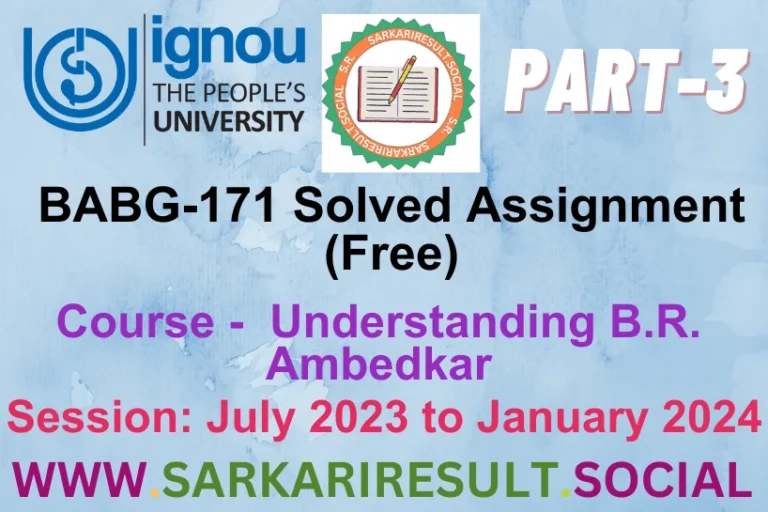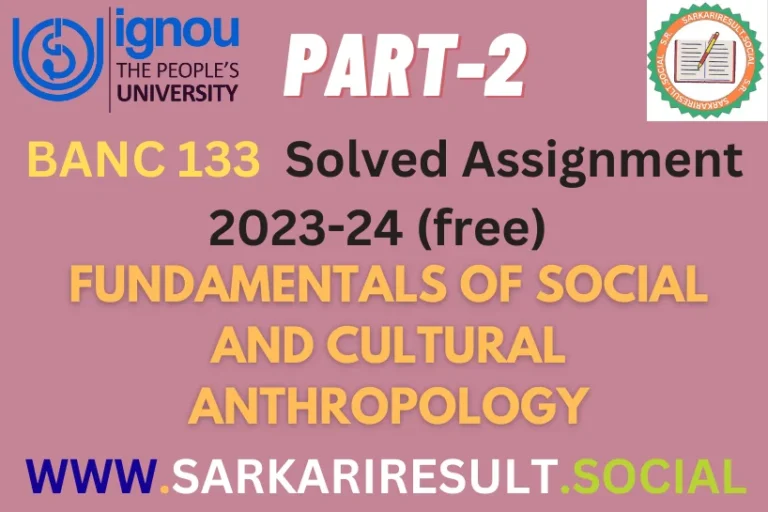BEGG 172 SOLVED IGNOU ASSIGNMENT FREE PART 2

Continue your journey into Language and Linguistics BEGG 172 SOLVED IGNOU ASSIGNMENT FREE PART 2 with Section B of our meticulously crafted IGNOU Solved Assignments 2024. Navigate questions based on Blocks 3 and 4 with precision. Delve into the intricate relationship between words in English, explore the concept of Morpheme, discuss common functional elements in sentences, and unravel the various types of English verbs along with types of verb phrases. Each answer is thoughtfully presented within 300 words, ensuring a comprehensive grasp of the course content.

Answer each question in about 300 words. (Based on Blocks 3 and 4)
Q.1 Discuss the relationship between words in English.
Ans. The English language is a vast and intricate system where words are interconnected through a web of relationships, contributing to the depth and nuance of communication. The relationships between words can be broadly categorized into several types, encompassing everything from synonyms to antonyms, hyponyms to hypernyms, and more.
1. Synonyms:
Words that share a similar or identical meaning are called synonyms. For example, “happy” and “joyful” are synonyms, both conveying a positive emotional state.
2. Antonyms:
Antonyms are words with opposite meanings. Examples include “hot” and “cold,” “fast” and “slow.” Understanding antonyms enhances precision in expression.
3. Homophones:
Words that sound the same but have different meanings and spellings are homophones. For instance, “pair” and “pear” or “write” and “right.”
4. Hyponyms and Hypernyms:
Hyponyms are specific words that fall under a broader category, known as hypernyms. For example, in the relationship between “rose” (hyponym) and “flower” (hypernym), a rose is a specific type of flower.
5. Meronyms and Holonyms:
Meronyms are parts or components of a whole, while holonyms refer to the whole itself. In the case of “finger” (meronym) and “hand” (holonym), fingers are parts of the hand.
6. Polysemy:
Polysemy occurs when a single word has multiple related meanings. For instance, “bat” can refer to a flying mammal or a piece of sports equipment.
7. Collocations:
Collocations are words that frequently appear together due to habitual usage, forming natural pairings like “strong coffee,” “heavy rain,” or “make a decision.”
8. Derivational Relationships:
Derivational relationships involve the formation of new words through prefixes, suffixes, or root changes. For instance, “happy” can become “unhappy” by adding the prefix “un.”
Understanding these relationships enhances vocabulary, aids in precise expression, and allows for a more nuanced understanding of the language. As speakers and writers navigate this intricate web of connections, they weave a semantic tapestry that captures the richness and complexity of English communication.
Q.2 What is a Morpheme? Discuss.
Ans. A morpheme is the smallest unit of meaning in a language. It is a fundamental concept in linguistics that helps analyze the structure and formation of words. Morphemes are the building blocks of words, and understanding them is crucial for deciphering the intricacies of language morphology.
Types of Morphemes:
1. Free Morphemes:
– Definition: These morphemes can stand alone as meaningful words.
– Example: In the word “playful,” both “play” and “ful” are free morphemes.
2. Bound Morphemes:
– Definition: These morphemes cannot stand alone but need to be attached to a free morpheme to convey meaning.
– Example: In the word “unhappiness,” “un-” and “-ness” are bound morphemes.
3. Roots:
– Definition: The core morpheme that carries the primary meaning of a word.
– Example: In the word “unhappiness,” “happy” is the root morpheme.
4. Affixes:
– Definition: Morphemes attached to roots to modify or extend their meaning.
– Example: In the word “unhappiness,” “un-” and “-ness” are affix morphemes.
Types of Morphological Processes:
1. Inflection:
– Definition: Involves changes to a word’s form to convey grammatical information.
– Example: “Walk” (base form) becomes “walks” (inflected for the third person singular).
2. Derivation:
– Definition: Formation of new words by adding affixes to existing words.
– Example: “Happy” (base word) becomes “unhappy” through the addition of the prefix “un-.”
3. Compounding:
– Definition: Creation of new words by combining two or more existing words.
– Example: “Rain” + “bow” = “rainbow.”
Importance of Morphemes:
1. Semantic Understanding:
– Morphemes carry meaning, and their analysis helps in understanding the semantic components of words.
2. Word Formation:
– Morphemes play a crucial role in word formation, including the creation of new words through derivation and compounding.
3. Grammar and Syntax:
– Inflectional morphemes contribute to grammatical nuances, indicating tense, number, or gender.
4. Language Acquisition:
– Morphological analysis is integral to language acquisition, as learners grasp the structure and meaning of words.
In essence, morphemes serve as the building blocks of language, offering insights into how words are structured, modified, and interconnected within a linguistic system.
Q.3 Discuss the common functional elements in sentences.
Ans. Sentences are complex structures that convey meaning by combining various functional elements. These elements work together to create clear communication and express different aspects of the message. Here are some common functional elements in sentences:
1. Subject:
– Function: The subject typically indicates the “doer” of the action or the one being described.
– Example: In the sentence “The cat is sleeping,” “The cat” is the subject.
2. Predicate:
– Function: The predicate contains the verb and provides information about the action or state of the subject.
– Example: In the sentence “The cat is sleeping,” “is sleeping” is the predicate.
3. Object:
– Function: The object receives the action of the verb, providing more details about the subject’s interaction.
– Example: In the sentence “She bought a book,” “a book” is the object.
4. Complement:
– Function: Complements provide additional information to complete the meaning of the sentence, often following linking verbs.
– Example: In the sentence “She seems happy,” “happy” is the complement.
5. Adverbial:
– Function: Adverbials modify the verb, providing details such as when, where, how, or to what degree the action occurs.
– Example: In the sentence “He runs quickly,” “quickly” is the adverbial.
6. Modifier:
– Function: Modifiers, including adjectives and adverbs, provide more information about nouns (adjectives) or verbs, adjectives, or other adverbs (adverbs).
– Example: In the sentence “The tall girl runs quickly,” “tall” is an adjective modifier, and “quickly” is an adverb modifier.
7. Conjunction:
– Function: Conjunctions connect words, phrases, or clauses, indicating relationships such as addition, contrast, or cause and effect.
– Example: In the sentence “She likes coffee, but he prefers tea,” “but” is the conjunction.
8. Clause:
– Function: Clauses are groups of words containing a subject and a predicate. They can be independent (stand-alone sentences) or dependent (require additional information).
– Example: In the sentence “When it rains, we stay indoors,” “When it rains” is a dependent clause.
Understanding and effectively using these functional elements contribute to sentence clarity, coherence, and the conveyance of nuanced meanings. Whether in spoken or written language, these elements form the essential structure of meaningful communication.
Q.4 Discuss various types of the English verbs and types of Verb phrases.
Ans. Types of English Verbs:
1. Action Verbs:
– Definition: Action verbs express physical or mental actions.
– Example: run, think, eat
2. Linking Verbs:
– Definition: Linking verbs connect the subject of a sentence to a subject complement, typically describing a state of being.
– Example: am, is, seem
3. Auxiliary (Helping) Verbs:
– Definition: Auxiliary verbs assist the main verb in forming tenses, questions, and negations.
– Example: be, have, do
4. Modal Verbs:
– Definition: Modal verbs express ability, possibility, necessity, or permission.
– Example: can, could, will, would
5. Transitive Verbs:
– Definition: Transitive verbs require a direct object to complete their meaning.
– Example: eat (something), write (a letter)
6. Intransitive Verbs:
– Definition: Intransitive verbs do not require a direct object to complete their meaning.
– Example: run, sleep
7. Dynamic Verbs:
– Definition: Dynamic verbs describe actions that can be seen or experienced.
– Example: jump, sing, swim
8. Stative Verbs:
– Definition: Stative verbs express a state or condition rather than a dynamic action.
– Example: like, know, believe
Types of Verb Phrases:
1. Simple Verb Phrase:
– Structure: Consists of a single main verb.
– Example: She eats.
2. Complex Verb Phrase:
– Structure: Involves a main verb and one or more auxiliary verbs.
– Example: He is studying for exams.
3. Modal Verb Phrases:
– Structure: Involves a modal verb followed by the base form of a main verb.
– Example: They can swim.
4. Perfect Verb Phrase:
– Structure: Involves a form of the verb “have” followed by the past participle of the main verb.
– Example: She has written the report.
5. Progressive (Continuous) Verb Phrase:
– Structure: Involves a form of the verb “be” followed by the present participle of the main verb.
– Example: We are playing football.
6. Passive Verb Phrase:
– Structure: Involves a form of the verb “be” followed by the past participle of the main verb.
– Example: The book was read by her.
Understanding the diverse roles of these verb types and phrases is crucial for constructing grammatically correct and meaningful sentences in English. The nuances in meaning and function contribute to the language’s richness and flexibility.
Also See This: BEGG 172 SOLVED IGNOU ASSIGNMENT FREE PART 3







